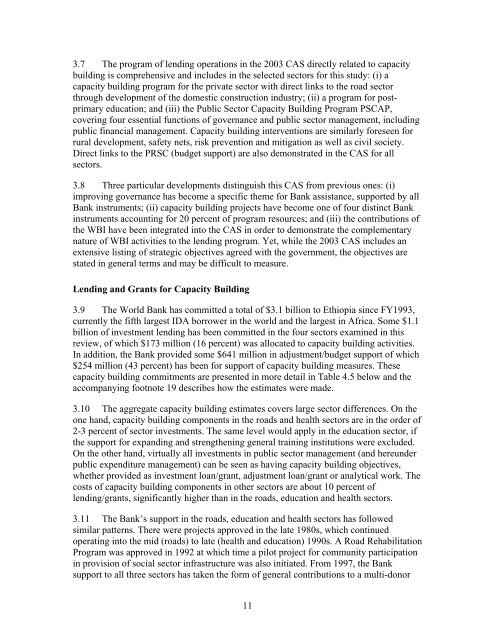An Independent Review of World Bank Support to ... - DAG Ethiopia
An Independent Review of World Bank Support to ... - DAG Ethiopia
An Independent Review of World Bank Support to ... - DAG Ethiopia
Create successful ePaper yourself
Turn your PDF publications into a flip-book with our unique Google optimized e-Paper software.
3.7 The program <strong>of</strong> lending operations in the 2003 CAS directly related <strong>to</strong> capacitybuilding is comprehensive and includes in the selected sec<strong>to</strong>rs for this study: (i) acapacity building program for the private sec<strong>to</strong>r with direct links <strong>to</strong> the road sec<strong>to</strong>rthrough development <strong>of</strong> the domestic construction industry; (ii) a program for postprimaryeducation; and (iii) the Public Sec<strong>to</strong>r Capacity Building Program PSCAP,covering four essential functions <strong>of</strong> governance and public sec<strong>to</strong>r management, includingpublic financial management. Capacity building interventions are similarly foreseen forrural development, safety nets, risk prevention and mitigation as well as civil society.Direct links <strong>to</strong> the PRSC (budget support) are also demonstrated in the CAS for allsec<strong>to</strong>rs.3.8 Three particular developments distinguish this CAS from previous ones: (i)improving governance has become a specific theme for <strong>Bank</strong> assistance, supported by all<strong>Bank</strong> instruments; (ii) capacity building projects have become one <strong>of</strong> four distinct <strong>Bank</strong>instruments accounting for 20 percent <strong>of</strong> program resources; and (iii) the contributions <strong>of</strong>the WBI have been integrated in<strong>to</strong> the CAS in order <strong>to</strong> demonstrate the complementarynature <strong>of</strong> WBI activities <strong>to</strong> the lending program. Yet, while the 2003 CAS includes anextensive listing <strong>of</strong> strategic objectives agreed with the government, the objectives arestated in general terms and may be difficult <strong>to</strong> measure.Lending and Grants for Capacity Building3.9 The <strong>World</strong> <strong>Bank</strong> has committed a <strong>to</strong>tal <strong>of</strong> $3.1 billion <strong>to</strong> <strong>Ethiopia</strong> since FY1993,currently the fifth largest IDA borrower in the world and the largest in Africa. Some $1.1billion <strong>of</strong> investment lending has been committed in the four sec<strong>to</strong>rs examined in thisreview, <strong>of</strong> which $173 million (16 percent) was allocated <strong>to</strong> capacity building activities.In addition, the <strong>Bank</strong> provided some $641 million in adjustment/budget support <strong>of</strong> which$254 million (43 percent) has been for support <strong>of</strong> capacity building measures. Thesecapacity building commitments are presented in more detail in Table 4.5 below and theaccompanying footnote 19 describes how the estimates were made.3.10 The aggregate capacity building estimates covers large sec<strong>to</strong>r differences. On theone hand, capacity building components in the roads and health sec<strong>to</strong>rs are in the order <strong>of</strong>2-3 percent <strong>of</strong> sec<strong>to</strong>r investments. The same level would apply in the education sec<strong>to</strong>r, ifthe support for expanding and strengthening general training institutions were excluded.On the other hand, virtually all investments in public sec<strong>to</strong>r management (and hereunderpublic expenditure management) can be seen as having capacity building objectives,whether provided as investment loan/grant, adjustment loan/grant or analytical work. Thecosts <strong>of</strong> capacity building components in other sec<strong>to</strong>rs are about 10 percent <strong>of</strong>lending/grants, significantly higher than in the roads, education and health sec<strong>to</strong>rs.3.11 The <strong>Bank</strong>’s support in the roads, education and health sec<strong>to</strong>rs has followedsimilar patterns. There were projects approved in the late 1980s, which continuedoperating in<strong>to</strong> the mid (roads) <strong>to</strong> late (health and education) 1990s. A Road RehabilitationProgram was approved in 1992 at which time a pilot project for community participationin provision <strong>of</strong> social sec<strong>to</strong>r infrastructure was also initiated. From 1997, the <strong>Bank</strong>support <strong>to</strong> all three sec<strong>to</strong>rs has taken the form <strong>of</strong> general contributions <strong>to</strong> a multi-donor11
















